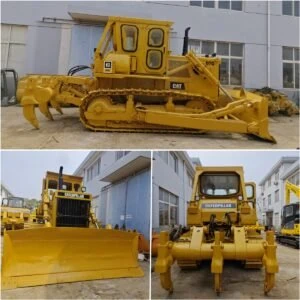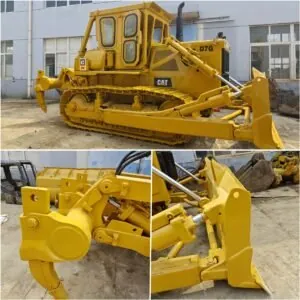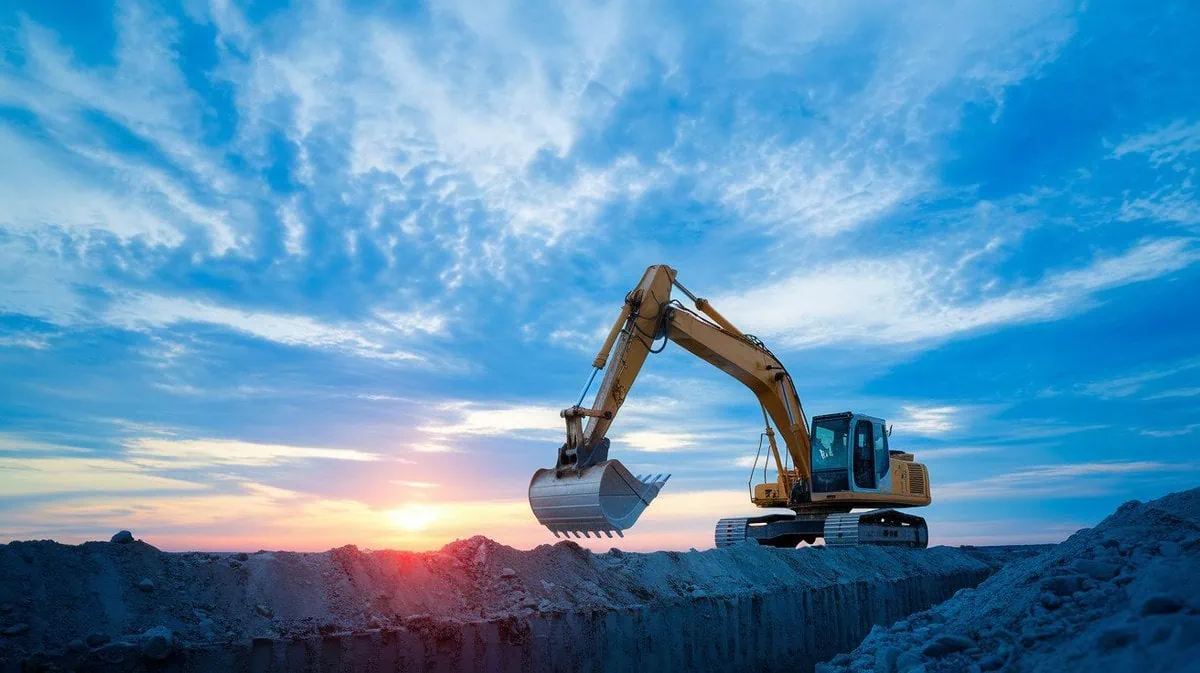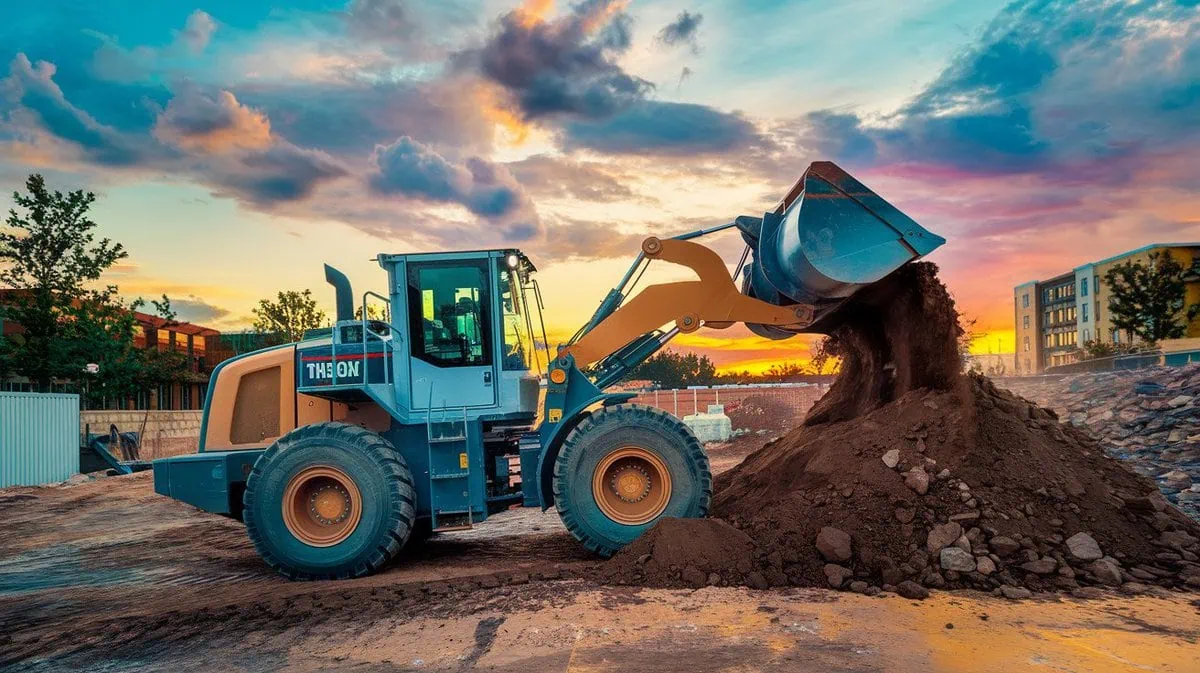Introduction:
The operation of used bulldozers serves as the backbone of various industries, including construction, mining, and agriculture, where they play an integral role in enhancing project efficiency and productivity. These robust machines are relied upon for a myriad of tasks, from earthmoving and land clearing to leveling and road construction. Their versatility and power make them indispensable assets in the modern industrial landscape.
However, despite their utility, operating bulldozers entails inherent risks that demand stringent safety measures to mitigate potential accidents and ensure operational effectiveness. The sheer size and power of these machines, coupled with the dynamic nature of worksites, pose significant hazards to both operators and bystanders. From rollovers and collisions to mechanical failures and environmental hazards, the potential risks associated with bulldozer operation are manifold.
Recognizing the paramount importance of safety in bulldozer operations, this paper aims to provide a comprehensive examination of the safety measures essential for the smooth and secure utilization of used bulldozers. By delving into various aspects of pre-operational preparations, workplace safety considerations, operational practices, continual monitoring, emergency protocols, and training initiatives, this paper endeavors to highlight the criticality of prioritizing safety at every stage of operation.
Indeed, safety is not merely a regulatory requirement or a moral obligation—it is a fundamental prerequisite for the sustainable and efficient operation of bulldozers in industrial settings. By adhering to rigorous safety protocols and fostering a culture of safety consciousness, organizations can mitigate risks, prevent accidents, and safeguard the well-being of their personnel and assets. Through this detailed exploration of safety measures, this paper seeks to underscore the indispensable role of safety in optimizing operational outcomes and ensuring the longevity of bulldozer operations in diverse industries.
Pre-operational Preparations:
Establishing a foundation for safe bulldozer operation begins with meticulous pre-operational preparations. Operators are entrusted with the crucial task of thoroughly acquainting themselves with the bulldozer’s operation manual, a comprehensive guide delineating essential operational procedures, safety protocols, and maintenance requirements. Understanding the manual’s content equips operators with invaluable insights into the proper handling and utilization of the bulldozer, thus mitigating the risk of errors or accidents during operation.
Furthermore, operators must conduct rigorous inspections of the mechanical and electronic systems of the bulldozer before initiating any work. This entails meticulous examination of components such as the engine, transmission, hydraulic systems, and electrical circuits to detect signs of wear, damage, or malfunction. Any anomalies identified during the inspection should be promptly addressed and rectified to ensure optimal efficiency and safety of bulldozer operation.
Additionally, ensuring operators possess the necessary training and qualifications is imperative for safe and proficient equipment operation. This encompasses obtaining relevant certifications and licenses, participating in specialized training programs, and accumulating practical experience under the guidance of seasoned professionals. By investing in comprehensive training initiatives, organizations empower operators with the knowledge, skills, and competencies essential for navigating the intricacies of bulldozer operations effectively, thereby minimizing accidents and enhancing operational efficiency.
Workplace Safety Considerations:
Creating a safe work environment is paramount to mitigate risks inherent in bulldozer operations. Initial steps in ensuring workplace safety involve conducting comprehensive assessments of the terrain and geological conditions at the worksite. Evaluation of factors such as ground stability, slope gradients, soil composition, and potential environmental hazards enables the identification of risks or challenges that may impact bulldozer operations.
Proactive measures should be taken to clear obstacles and hazards from the work area to facilitate the safe and unobstructed operation of the bulldozer. Removal of debris, rocks, tree stumps, and other impediments minimizes threats to personnel or equipment during operation. By maintaining a clear and hazard-free work environment, organizations minimize the likelihood of accidents and injuries, ensuring the safety and well-being of all personnel involved in bulldozer operations.
Furthermore, ensuring adequate ventilation and lighting within the work area is essential to enhance visibility and minimize potential accidents. Poor lighting conditions or inadequate ventilation impair operators’ ability to accurately assess their surroundings and react promptly to hazards, increasing the risk of accidents or collisions. Prioritizing adequate lighting and ventilation measures fosters a safer and more conducive work environment for bulldozer operation, thereby reducing the likelihood of accidents and injuries. Pre-operational Preparations:
Before commencing operation, thorough pre-operational preparations are crucial. This involves familiarizing oneself with the bulldozer’s operation manual, inspecting mechanical and electronic systems for any malfunctions, and ensuring operators possess requisite training and qualifications.
Ensuring adherence to safe practices during bulldozer operations is crucial to mitigate risks and uphold the safety of personnel. One of the fundamental aspects of safe operation involves implementing proper ingress and egress procedures. Operators must embark and safely disembark the bulldozer, utilizing designated access points and maintaining three-point contact with the vehicle to prevent slips, trips, or falls. This approach minimizes the risk of accidents and injuries, especially when entering or exiting the bulldozer, which can be particularly hazardous due to its elevated position and uneven terrain.
Furthermore, the consistent use of safety belts and other personal protective equipment (PPE) is essential to minimize the risk of injury in the event of accidents or rollovers. Safety belts restrain operators securely in their seats, preventing ejection or severe impacts during sudden stops or rollover incidents. Additionally, the utilization of helmets and reflective vests enhances visibility provides additional protection against head injuries, and increases operators’ visibility to others on the worksite, reducing the likelihood of accidents involving other personnel or equipment.
Moreover, operators must rigorously adhere to speed limits and operational protocols outlined in the bulldozer’s operation manual and relevant regulations. Operating the bulldozer within designated speed limits ensures optimal control and maneuverability while minimizing the risk of accidents, collisions, or mechanical failures. Deviating from established operational procedures can compromise safety and increase the likelihood of accidents or damage to equipment and property. By maintaining strict adherence to these guidelines, operators contribute to a safer work environment and effectively mitigate potential hazards associated with bulldozer operations.
In essence, by prioritizing safe practices such as proper ingress and egress procedures, consistent use of safety belts and PPE, and adherence to speed limits and operational protocols, operators can significantly enhance safety levels during bulldozer operations. Through these measures, the risk of accidents and injuries is minimized, ensuring the well-being of personnel and the smooth execution of tasks in various work environments.
Continual Monitoring and Maintenance:
Continuous monitoring and proactive maintenance are integral components of ensuring the safe and efficient operation of bulldozers. Regular checks of mechanical and electronic systems are essential to identify any signs of wear, damage, or malfunction that may compromise safety or operational efficiency. Operators should conduct thorough inspections of critical components such as the engine, transmission, hydraulic systems, and electrical circuits, paying close attention to fluid levels, belt tensions, and component integrity.
Vigilant observation for unusual noises, vibrations, or warning indicators during operation can serve as early warning signs of potential issues requiring immediate attention. Any abnormalities detected should be promptly investigated and addressed to prevent further damage or operational disruptions. Additionally, timely maintenance and servicing of the bulldozer, including lubrication, filter replacements, and component adjustments, are essential for prolonging the equipment’s lifespan and ensuring reliable performance.
By prioritizing continual monitoring and maintenance practices, organizations can mitigate the risk of unexpected failures, minimize downtime, and optimize operational efficiency. Furthermore, a proactive approach to maintenance fosters a culture of safety consciousness among operators, encouraging vigilance and attentiveness to potential hazards. Ultimately, the combination of regular monitoring, proactive maintenance, and prompt addressing of issues contributes to the overall safety and operational effectiveness of bulldozer operations.
Emergency Protocols:
In situations of emergency, the presence of well-defined protocols is of paramount importance to effectively manage unforeseen incidents and minimize potential damages. Training personnel in comprehensive emergency procedures equips them with the knowledge and skills necessary to respond swiftly and effectively to various emergency scenarios. This training encompasses protocols for evacuations, first aid administration, and communication procedures, ensuring that personnel are adequately prepared to handle emergencies with composure and efficiency.
Additionally, the utilization of emergency shutdown devices plays a crucial role in mitigating potential hazards and preventing further escalation of emergencies. These devices are designed to swiftly deactivate machinery or equipment in the event of an emergency, thereby minimizing risks associated with continued operation and facilitating the safe evacuation of personnel. Regular testing and maintenance of emergency shutdown systems are essential to ensure their reliability and effectiveness when needed most.
Furthermore, prompt communication and coordination are vital components of effective emergency response. Personnel must be trained to promptly notify relevant stakeholders, including supervisors, emergency response teams, and regulatory authorities, of any emergencies or incidents. Clear communication channels and escalation procedures should be established to facilitate the dissemination of information and ensure timely assistance and support are rendered to personnel in distress.
By implementing well-defined emergency protocols and providing comprehensive training to personnel, organizations can minimize the impact of emergencies, safeguard personnel safety, and mitigate potential damages to equipment and property.
Training Initiatives:
Continuous training and education serve as cornerstones in fostering a culture of safety within organizations. Providing ongoing training sessions and opportunities for operators to enhance their skills and knowledge not only reinforces safety protocols but also cultivates a proactive attitude toward safety among personnel. These training initiatives cover a wide range of topics, including equipment operation, hazard identification, emergency response procedures, and regulatory compliance.
Moreover, facilitating opportunities for operators to share experiences and insights fosters a collaborative learning environment where best practices can be exchanged and knowledge can be collectively leveraged to enhance safety awareness and operational efficiency. Peer-to-peer learning initiatives, such as safety committees, toolbox talks, and mentorship programs, enable operators to learn from each other’s experiences, gain valuable insights into potential hazards, and develop strategies for risk mitigation.
Furthermore, incorporating interactive and engaging training methods, such as simulations, role-playing exercises, and scenario-based training, enhances retention and comprehension of safety concepts among personnel. By tailoring training initiatives to address specific industry hazards and operational challenges, organizations can empower personnel with the skills and competencies necessary to navigate complex work environments safely and effectively.
Ultimately, investing in continuous training and education initiatives not only enhances safety awareness but also contributes to improved operational efficiency, reduced downtime, and enhanced overall performance within organizations. By prioritizing safety as a core value and providing ongoing support and resources for personnel development, organizations can create a culture of safety excellence that permeates every aspect of their operations.
Conclusion:
In conclusion, the safe operation of used bulldozers demands meticulous attention to various safety measures throughout every aspect of their use. From pre-operational preparations to workplace safety considerations, adherence to operational practices, continual monitoring, emergency protocols, and training initiatives, each step plays a crucial role in mitigating risks and ensuring the well-being of personnel and the preservation of assets.
Prioritizing safety from the outset, operators must thoroughly familiarize themselves with operation manuals, conduct thorough inspections, and ensure adequate training and qualifications. Additionally, creating a safe work environment through comprehensive assessments, proactive hazard mitigation, and adherence to operational protocols is essential for minimizing risks during operation.
Continual monitoring and maintenance are vital for identifying and addressing potential issues promptly, preventing operational disruptions and safety hazards. In emergencies, well-defined protocols enable swift and effective response, minimizing damages and ensuring personnel safety.
Lastly, continuous training and education initiatives foster a culture of safety consciousness among personnel, empowering them with the skills and awareness necessary to navigate potential hazards confidently and responsibly.
By emphasizing these safety measures, organizations can effectively manage the risks associated with bulldozer operation, optimize operational outcomes, and safeguard personnel and assets, thereby promoting a culture of safety excellence in the workplace.








